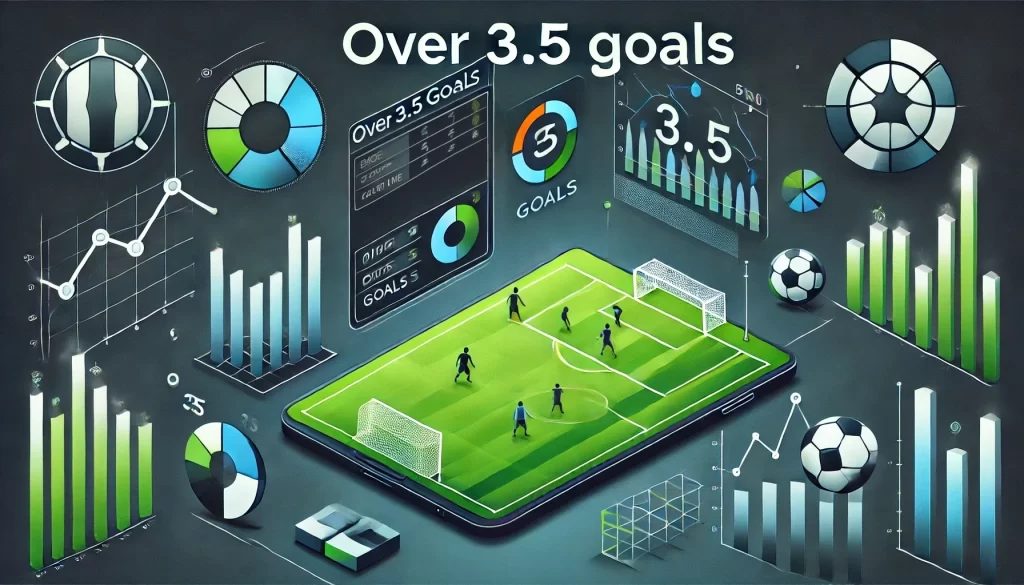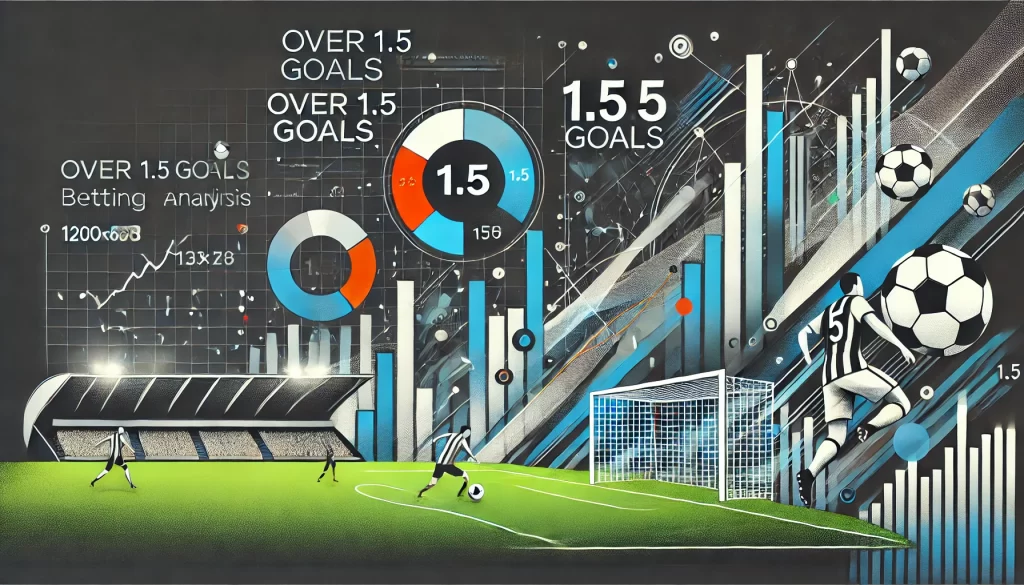Introduction
Football betting is a dynamic and ever-evolving field, offering many strategies for bettors seeking an edge. One of the most reliable and potentially profitable strategies is Under 3.5 Goals betting. Whether you are a seasoned bettor or new to the game, this approach offers a balanced mix of predictability and value, making it a favourite among those looking to generate consistent returns. In this article, we will explore the intricacies of Under 3.5 Goals betting and trading, uncovering the benefits, tactics, and non-statistical factors that can tip the odds in your favour.
Under 3.5 Goals betting isn’t just about predicting the number of goals in a match—it’s about understanding the rhythm of the game, the strategies of the teams, and the external factors that influence play. By the end of this guide, you’ll be equipped with the knowledge to make informed bets, backed by both statistical analysis and insightful qualitative assessments. Let’s dive in and see how you can leverage this strategy for long-term success.
What Is Under 3.5 Goals Betting and Trading?
Under 3.5 Goals Betting is a market where you wager on the total number of goals scored in a match being three or fewer. If the match concludes with 0, 1, 2, or 3 goals, your bet is a winner. However, if four or more goals are scored, the bet is lost. This market is appealing due to its relative safety, especially in matches featuring teams with strong defensive records or where a low-scoring game is expected.
On the other hand, Under 3.5 Goals Trading involves using a betting exchange platform to place bets both for and against the occurrence of fewer than 3.5 goals during the course of a match. Traders can “lay” the Under 3.5 Goals market if they believe more goals will be scored and then “back” it later to secure a profit, or vice versa. This approach allows for dynamic betting where the trader can adjust their position as the match progresses, offering opportunities to lock in profits or minimize losses depending on how the game unfolds.
The key difference between betting and trading lies in flexibility and timing. Traditional betting requires you to make a decision before the match and stick with it, while trading allows you to react to the live developments of the game, making it more interactive and potentially more profitable for those who understand the nuances of in-play betting.
Benefits of Under 3.5 Goals Betting
1. Increased Predictability:
Football matches, especially those involving defensively strong teams or matches with significant stakes, often end with fewer goals. Under 3.5 Goals betting takes advantage of these scenarios, where the likelihood of a goal-fest is low. The margin of three goals provides a buffer, making it easier to predict and reducing the risk compared to more restrictive markets like Under 2.5 Goals.
2. Lower Risk, Higher Success Rate:
Because the Under 3.5 Goals market allows for up to three goals, it inherently carries a lower risk compared to markets that bet on fewer goals. This flexibility increases the chances of your bet being successful, particularly in tightly contested matches where defences dominate.
3. Steadier Returns:
Under 3.5 Goals betting is less volatile than other markets, such as Correct Score or Over 2.5 Goals. It allows bettors to capitalize on matches that are likely to be low-scoring without needing to predict the exact number of goals. This steadiness makes it an attractive option for those looking to build a long-term betting strategy with consistent returns.
4. Versatility in Various Match Types:
Whether it’s a league match between two defensive sides or a cup final where the stakes are high, Under 3.5 Goals betting can be applied to a wide range of fixtures. This versatility makes it a go-to market for many bettors, allowing them to find value in different types of matches throughout a season.
Non-Statistical Aspects of Analysis
While statistical analysis forms the backbone of any successful betting strategy, understanding the non-statistical factors that influence a match can provide a significant edge. Here are some key non-statistical elements to consider when analyzing the Under 3.5 Goals market:
1. Team Motivation and Match Context:
The motivation behind each team’s approach to the game can drastically influence the number of goals scored. For instance, in the closing stages of a league season, teams fighting for survival or chasing a critical spot may adopt a more cautious approach, prioritizing defense over attack. Similarly, in knockout stages of tournaments or high-stakes matches, teams might avoid taking risks, resulting in fewer goals. Understanding the context of the match—whether it’s a derby, a must-win game, or a fixture with less at stake—can provide clues about the likely tempo and goal output.
2. Weather and Pitch Conditions:
Environmental factors such as weather can have a substantial impact on how a game unfolds. Wet, windy, or extremely hot conditions often slow down the pace of the match, reducing the number of scoring opportunities. For example, a heavy rainstorm can make the pitch slippery, causing players to be more cautious, thus lowering the overall tempo and the chances of goals. Similarly, a poorly maintained pitch might hinder quick passing and fluid attacking play, favouring a lower-scoring game.
3. Team Tactics and Managerial Style:
Analyzing the playing styles of the teams and the tactical preferences of their managers is crucial. Teams known for strong defensive setups or managers who prioritize structure and discipline over flair and attack are likely to produce games with fewer goals. For example, managers like Diego Simeone or José Mourinho are often associated with defensive solidity and tactical conservatism, making Under 3.5 Goals a viable option when their teams are involved.
4. Player Availability and Fatigue:
The presence or absence of key players can significantly influence the outcome of a match. Injuries to star attackers or suspensions of key defenders can change a team’s approach, either limiting their ability to score or making them more vulnerable at the back. Additionally, fatigue can play a critical role, especially for teams that have had a congested fixture list. Fatigued teams might lack the energy to sustain high-intensity attacks, leading to a slower-paced game with fewer goals. This is something that we monitor in our Rest Days analysis in the Analytics PRO tool.
5. Referee Influence:
Referees can subtly shape the dynamics of a match, especially in how they handle fouls and discipline. A referee known for a strict approach might keep the game tight and controlled, reducing the likelihood of free-flowing, high-scoring play. Conversely, a lenient referee might allow a more physical game, potentially disrupting attacking moves and keeping the score low.
Bridging Non-Statistical and Statistical Analysis
While these non-statistical factors are vital, their real power lies in how they complement statistical analysis. By integrating qualitative insights with quantitative data, you can form a more complete picture of the match, enabling smarter bets in the Under 3.5 Goals market. As we move forward, we will delve into the statistical analysis that can further refine your approach and highlight where the true value lies.
By understanding both the numbers and the nuances of football, you can make informed decisions that stand the test of time, setting you up for consistent success in your betting endeavours.
Statistical Analysis for Helmond Sport vs VVV-Venlo – Under 3.5 Goals Betting
Match Date: August 30, 2024
Teams: Helmond Sport vs VVV-Venlo
Odds: 2.57 (Helmond Sport) | 3.72 (Draw) | 2.93 (VVV-Venlo)
Market Focus: Under 3.5 Goals @ 1.43
1. Long-Term Trends (Last 3 Seasons)

Helmond Sport’s Home Matches:
- No. of Matches: 6
- Profit/Loss: +1.58 units
- Average Odds: 1.49
- ROI: 26.33%
Helmond Sport’s long-term home trends show strong performance in low-scoring games. Across six matches where their win odds fell between 2.4 and 2.7, the Under 3.5 Goals market has yielded a healthy 26.33% ROI. This trend suggests that when Helmond Sport is closely matched or slightly favored, the games tend to be controlled and lower-scoring.
VVV-Venlo’s Away Matches:
- No. of Matches: 4
- Profit/Loss: +0.31 units
- Average Odds: 1.49
- ROI: 7.75%
VVV-Venlo’s long-term away performance also supports the Under 3.5 Goals market, albeit with a more modest ROI. In matches where their win odds fell between 2.8 and 3.1, their away games have typically been tight and low-scoring. The ROI of 7.75% reflects the defensive discipline VVV-Venlo often displays on the road against similarly ranked opponents.
Summary:
Both teams have shown a consistent trend towards low-scoring matches in long-term scenarios where the odds suggest a closely contested game. This supports the viability of the Under 3.5 Goals market for this fixture.
2. Medium-Term Trends (Last 10 Home/Away Matches)
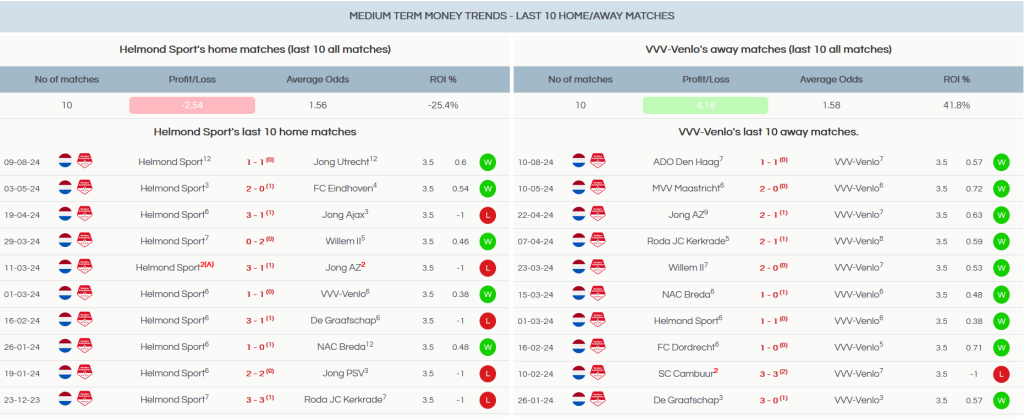
Helmond Sport’s Last 10 Home Matches:
- No. of Matches: 10
- Profit/Loss: -2.54 units
- Average Odds: 1.56
- ROI: -25.4%
Helmond Sport’s medium-term home form shows some volatility, with a negative ROI of -25.4%. However, despite the mixed results, most of their matches have remained low-scoring, which aligns with the Under 3.5 Goals market. This dip in profitability might indicate some recent instability, but it also highlights the importance of looking beyond just ROI when assessing value in low-scoring markets.
VVV-Venlo’s Last 10 Away Matches:
- No. of Matches: 10
- Profit/Loss: +4.18 units
- Average Odds: 1.58
- ROI: 41.8%
VVV-Venlo’s away form over the last 10 matches presents a strong case for backing Under 3.5 Goals, with a positive ROI of 41.8%. This indicates that VVV-Venlo has consistently been involved in matches that feature fewer than four goals, reinforcing their reputation for defensive solidity when playing away from home.
Summary:
While Helmond Sport’s recent home matches show some inconsistency, VVV-Venlo’s strong away performance in the Under 3.5 Goals market provides compelling support for this bet. The overall medium-term trends point towards a match that is likely to stay under the 3.5 goal mark.
3. Short-Term Trends (Last 6 Matches)

Helmond Sport’s Last 6 Matches:
- No. of Matches: 6
- Profit/Loss: +3.66 units
- Average Odds: 1.61
- ROI: 61%
Helmond Sport’s short-term form is impressive, with a 61% ROI from their last six matches. This suggests that the team has recently tightened up defensively, contributing to a series of low-scoring outcomes. The trend supports the continuation of this pattern in their upcoming match.
VVV-Venlo’s Last 6 Matches:
- No. of Matches: 6
- Profit/Loss: +1.93 units
- Average Odds: 1.56
- ROI: 32.17%
VVV-Venlo’s short-term away form also aligns with low-scoring matches, boasting a positive ROI of 32.17%. This consistency in recent games suggests that VVV-Venlo is likely to continue their defensive approach, making Under 3.5 Goals a strong bet.
Summary:
The short-term trends for both teams indicate a strong likelihood of a low-scoring match, with both sides showing recent form that favors Under 3.5 Goals.
4. Head-to-Head Trends
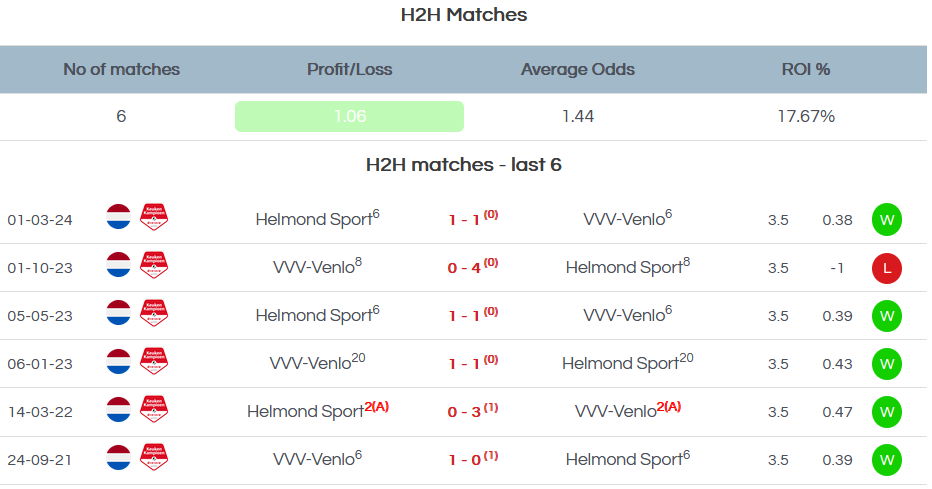
- No. of Matches: 6
- Profit/Loss: +1.06 units
- Average Odds: 1.44
- ROI: 17.67%
The head-to-head data between Helmond Sport and VVV-Venlo over the last six meetings suggests a tendency towards lower-scoring games. With a positive ROI of 17.67% in these encounters, the Under 3.5 Goals market has been profitable. This consistent history further strengthens the case for a low-scoring outcome in their upcoming fixture.
Summary:
The head-to-head trends support the Under 3.5 Goals market, indicating that matches between these two sides have historically been tight and low-scoring.
5. Poisson Distribution Models
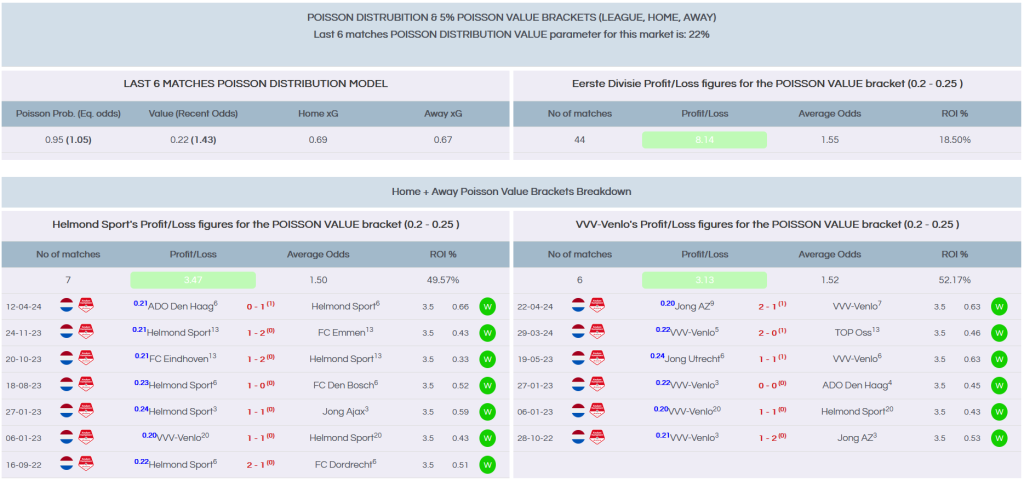
- Poisson Probability (Equivalent Odds): 0.95 (1.05)
- Value (Recent Odds): 0.22 (1.43)
- Home xG: 0.69
- Away xG: 0.67
The Poisson model estimates a 95% probability of the match ending under 3.5 goals, with equivalent odds of 1.05. Given the current market odds of 1.43, this suggests a significant value in betting on Under 3.5 Goals. The xG (expected goals) for both Helmond Sport and VVV-Venlo further supports this, with both teams averaging well below the threshold for a higher-scoring game.
Eerste Divisie’s Poisson Value Bracket Performance:
- No. of Matches: 44
- Profit/Loss: +8.14 units
- Average Odds: 1.52
- ROI: 18.50%
Helmond Sport’s Poisson Value Bracket Performance:
- No. of Matches: 7
- Profit/Loss: +3.47 units
- Average Odds: 1.50
- ROI: 49.57%
VVV-Venlo’s Poisson Value Bracket Performance:
- No. of Matches: 6
- Profit/Loss: +3.13 units
- Average Odds: 1.52
- ROI: 52.17%
League’s trends for matches in this value bracket show nice sample and healthy profit for backing under 3.5 goals. Furthermore, both teams have been highly profitable within their respective Poisson value brackets, reinforcing the likelihood of a low-scoring outcome in this match. The ROI percentages are particularly impressive, indicating that these value brackets have consistently delivered results.
Summary:
The Poisson model and xG analysis strongly support the Under 3.5 Goals market, with substantial value and high profitability in similar match scenarios.
6. League-Wide Trends: Eerste Divisie Goals Averages

Full-Time Goals Averages:
- 3-Season Average: 3.06
- Current Season Average: 2.67
- Last 100 Matches Average: 3.05
- Last 30 Matches Average: 2.67
The current season average for goals in the Eerste Divisie is 2.67, a notable drop from the three-season average of 3.06. This suggests a league-wide trend towards fewer goals per match this season, making the Under 3.5 Goals market even more appealing.
Under 3.5 Goals Averages:
- 3-Season Average: 64.09% (Equivalent Odds: 1.56)
- Current Season Average: 70% (Equivalent Odds: 1.43)
- Last 100 Matches Average: 67% (Equivalent Odds: 1.49)
- Last 30 Matches Average: 70% (Equivalent Odds: 1.43)
The percentage of matches ending with under 3.5 goals this season is higher than the three-season average, standing at 70%. The equivalent odds of 1.43 match the current market odds, indicating that the market is aligned with the prevailing trends in the league.
Summary:
The league-wide trends for the current season indicate a decrease in overall goals, with a significant percentage of matches falling under 3.5 goals. This aligns with the Under 3.5 Goals odds for the Helmond Sport vs VVV-Venlo match, suggesting that the market accurately reflects the broader league context.
7. Same Time Last Year Trends
For some markets, it’s also good to analyze seasonal trends e.g. early season matches, Christmas/winter periods, end of the season fixtures for their quirky patterns. They may not align perfectly every season but sometimes it’s a welcome confirmation/negation of your particular analysis angle.

Helmond Sport’s Matches:
- No. of Matches: 7
- Profit/Loss: +3.55 units
- Average Odds: 1.51
- ROI: 50.71%
VVV-Venlo’s Matches:
- No. of Matches: 5
- Profit/Loss: +1.18 units
- Average Odds: 1.55
- ROI: 23.6%
The trends from the same time last year (early season matches) show both teams performing well in low-scoring games. Helmond Sport, in particular, has demonstrated a strong ROI of 50.71%, indicating that they were involved in several matches with
ELO ratings model
Unfortunately no ELO ratings are available for Eerste divisive at this time, so this analysis angle is committed for this particular match.
Analysis – Conclusion
The match between Helmond Sport and VVV-Venlo on August 30, 2024, presents a compelling case for betting on the Under 3.5 Goals market. By analyzing a comprehensive set of long-term, medium-term, and short-term trends, as well as head-to-head data, Poisson distribution models, and league-wide trends, we can confidently identify this market as a value bet.
Key Takeaways:
- Long-Term Trends: Both teams have shown a consistent pattern of low-scoring matches in similar odds brackets over the past three seasons. This is particularly true for Helmond Sport at home and VVV-Venlo on the road, where the Under 3.5 Goals market has yielded positive returns.
- Medium-Term and Short-Term Trends: Despite some volatility in Helmond Sport’s recent home form, the medium and short-term trends still point towards a strong likelihood of a low-scoring match. VVV-Venlo’s away form further supports this, with a solid ROI in the Under 3.5 Goals market across their last ten away games.
- Head-to-Head Data: Historical encounters between these two teams have generally been low-scoring, reinforcing the potential for another tight match.
- Poisson Distribution Models: The Poisson probability and expected goals (xG) analysis indicate a strong value in the Under 3.5 Goals market, with both teams performing well within their respective Poisson value brackets.
- League-Wide Trends: The Eerste Divisie’s current season trends towards lower overall goal averages align with the Under 3.5 Goals market, reflecting a broader shift towards fewer goals in the league.
The Importance of Combining Statistical Components in Betting Analysis
When conducting a comprehensive betting analysis, it’s crucial to consider various statistical components, each offering unique insights into the potential outcome of a match. These components include long-term, medium-term, and short-term trends, head-to-head data, Poisson distribution models, ELO stats and broader league-wide trends. Each element provides a different perspective, helping to paint a fuller picture of the match’s likely dynamics. However, it’s important to understand that not all these elements need to align perfectly in favor of a particular bet.
The key to effective betting is to weigh the positives and negatives across these different aspects, rather than relying solely on a single piece of data. For instance, a strong long-term trend might be tempered by recent short-term volatility, or a positive Poisson model might contrast with weaker head-to-head performance. By carefully considering the balance of these factors, you can make a more informed decision on whether a bet represents true value.
It’s also essential to recognize that even the most robust statistical records are not foolproof predictors of future outcomes. Past performance can provide valuable guidance, but the unpredictable nature of sports means there is always an element of risk. Therefore, while a comprehensive statistical analysis can significantly increase your chances of making profitable bets, it’s important to approach each decision with a degree of caution and to manage expectations accordingly.
It takes time to learn analyzing markets and their statistical components. You may be able to find your edge or interesting angle one of the components e.g. H2H trends or Poisson Distribution models despite all the other components advice against particular outcome. Practice, experience and make your own judgements.

